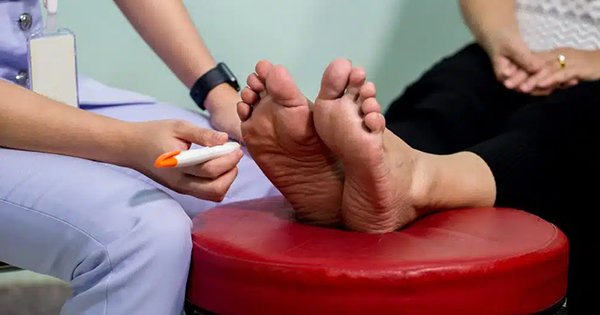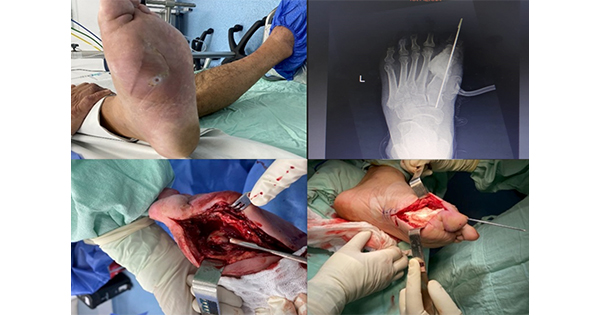Critical limb ischaemia (CLI) is the terminal stage of peripheral arterial disease (PAD) and the prevalence of both conditions is increasing rapidly. Only 10–20% of patients with PAD present with claudication, and 50% will be asymptomatic. CLI may be the first presentation of PAD in some patients.
There are many risk factors for developing PAD, including hypertension, smoking, diabetes, being male, being of older age, and blood lipid abnormalities. PAD is associated with cerebral vascular disease and coronary artery disease.
CLI is a clinical diagnosis made when a patient’s symptoms (such as resting pain, ulceration and gangrene) are due to arterial insufficiency. This arterial insufficiency results in inadequate oxygenation of the tissues for them to remain viable, heal a wound or prevent the spread of infection. Without treatment, CLI will almost always lead to amputation.
CLI is associated with a significantly increased risk of myocardial infarction, stroke, amputation and death — 30% of patients will undergo a major amputation and 25% will die within 1 year of a diagnosis of CLI (Ouriel, 2001; Novo et al, 2014).
In a 12-month period during 2010–2011 in the author’s Trust, 70 major amputations (i.e. amputations above the ankle) were carried out. More above-knee amputations than below-knee were carried out and more were performed on people without diabetes than on those with diabetes, which initially seems surprising (Figure 1). However, people with diabetes make up only 3.5% of the population of the Trust catchment area, although they are 24 times more likely to undergo amputation than people without diabetes. In the author’s Trust, there has been a 30% increase in major amputations in the past 5 years.
Investigations and imaging for PAD
After a thorough clinical examination, investigation of PAD will usually include measuring the ankle brachial pressure index (ABPI). The blood pressure at the ankle is divided by the higher of the two blood pressures measured in the arms.
PAD has been defined as an ABPI ≤ 0.9 (Meijer et al, 1998). People with diabetes, however, often have calcified vessels, making them incompressible and rendering the ABPI unreliable. It is often the case that people with diabetes, who clearly have PAD or even CLI, have an ABPI >1.
Imaging is, therefore, central in the investigation of patients with CLI and there are many options.
Magnetic resonance arteriography
Magnetic resonance arteriography (MRA), usually performed after an intravenous injection of gadolinium as a contrast agent, can provide excellent images of the arteries (Figure 2). The image quality can vary between manufacturers and in different clinical situations (Figure 3).
While MRA may provide good images of the lumen of the arteries, it provides no information about the vessel wall and the amount of calcification present, which is important when considering treatment, including surgery. Calcified vessels are difficult to stitch and may crack when clamped prior to opening the vessel for endarterectomy or grafting.
Computed tomography angiography
Computed tomography angiography (CTA) can be very helpful in providing information about the lumen and the vessel wall. The images can be manipulated and displayed in a variety of ways to analyse the vessels and the degree of narrowing within them.
Intravenous iodine-containing contrast agents are injected rapidly into a peripheral vein about 25 seconds before the scan is performed. These show the contrast in the arteries. The contrast appears white on the scan. Calcium also shows up as white, but is usually whiter than contrast agent (Figure 4).
The software used on CT workstations can be used to follow an artery on the CTA (even though this is rather tortuous), which enables the vessel to be displayed in one plane. The radiologist moves the cursor along the vessel and then can stop at any point to view the cross-sectional image (Figures 5 and 6).
As the blood vessels get smaller, it is increasingly difficult to know if the vessels are patent (open) or occluded. Figure 7 shows circumferential calcification in the superficial femoral artery, popliteal and calf vessels. Contrast is seen in the superficial femoral artery so the vessel is patent, but it is difficult to know if the smaller blood vessels are occluded.
The best way to demonstrate arterial patency is arteriography with a catheter inside the artery. Contrast is injected into the artery where it mixes and travels with the blood. Cross-sectional or axial CT images can be reconstructed in any plane (Figure 8).
Digital subtraction angiography
Digital subtraction angiography (DSA) is used to give high-quality images using relatively small quantities of contrast agents.
The equipment takes an image of the limb before contrast is injected and then a series of images as the contrast passes along the artery. A computer then subtracts the initial image without contrast (the mask) from the images with contrast. This removes all the background anatomy, leaving only the images of the vessels (Figure 9).
With a catheter inside the arterial lumen, treatment of a narrowing or occlusion can be performed by angioplasty.
A guide wire is passed across a narrowed segment of artery and a catheter with a balloon on the end is passed over this, to lie in the narrowed segment (Figure 10). The diameter of the balloon is chosen to match the size of the vessel.
The balloon is then inflated to a fairly high pressure, usually about 4–6 atmospheres. This stretches the vessel up to normal size, crushing the atheroma into the wall of the vessel.
Occlusions are more difficult to treat because a passage through the occluded segment must first be found, using a guide wire and catheter. On occasion, the guide wire crosses the occlusion inside the lumen, but sometimes the radiologist will chose to pass the guide wire into the wall of the artery and make a new channel within the layers of the arterial wall; a process called a subintimal angioplasty.
Disease in the calf vessels is particularly common in people with diabetes and the occluded segments are very often calcified, making them difficult or sometimes impossible to pass (Figure 11).
Conclusion
Clinicians often seem to be trying to salvage limbs that have already developed severe ischaemic damage, gangrene and/or osteomyelitis and it would be preferable to intervene earlier.
In patients with diabetes, it can be very difficult to differentiate an ischaemic limb from a neuropathic limb, especially when ischaemia can cause numbness and paralysis.
CLI is defined as being caused by insufficient oxygenation of tissues to maintain their viability. If we could measure the tissue oxygenation, perhaps this would allow us to identify limbs at threat, treat patients earlier and prevent the development of these complications of PAD. Transcutaneous oxygen measurement can be performed cheaply and non-invasively, although it does not seem to have been used for this purpose as yet. Research into this application would seem to be an obvious next step.




